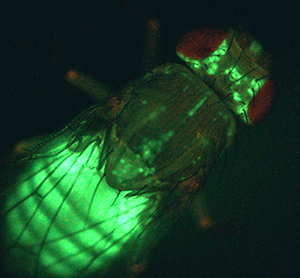
Experiments in a fruit fly model offer useful insights into a potentially important clinical target in human obesity and diabetes.
© 2013 European Molecular Biology Laboratory
An organelle called the endoplasmic reticulum (ER) helps to process newly synthesized proteins destined for delivery to the cell membrane. When the ER becomes overloaded and begins to accumulate poorly folded proteins, an ‘ER stress’ response ensues. ER stress tends to occur in obesity and other metabolic disorders. Now, research from Stephen Cohen and colleagues at the A*STAR Institute of Molecular and Cell Biology has revealed a potential therapeutic target linking ER stress to the onset of diabetes.
Cohen’s team initially set out to identify components of the insulin signaling pathway. “We were screening for genes involved in tissue growth control in the fly,” he says (see image). “Growth is regulated in part by the insulin pathway, so such screens can also pick up genes that function as metabolic regulators.” Their screen focused on FOXO, a protein that acts as a regulator of other genes. Insulin signaling causes FOXO to segregate in the cytoplasm, so that it can no longer bind its target genes in the nucleus. The researchers therefore searched for other genes that modulate FOXO activity.
They uncovered a link between PERK, a protein that disseminates signals involved in ER stress, and FOXO. When they genetically modified fruit flies to produce excess FOXO, this protein suppressed insulin-induced growth and the flies matured with small, underdeveloped eyes. However, when the researchers also reduced PERK levels in these flies, eye development returned to normal, indicating that PERK helps amplify the effects of FOXO.
Follow-up experiments demonstrated that PERK introduces chemical modifications to FOXO that help direct this protein to the nucleus where it executes its gene regulatory functions. Cohen and colleagues demonstrated that PERK also boosts FOXO function in human cells, and found that lowering PERK activity increased these cells’ sensitivity to insulin signaling. FOXO also helps to promote insulin sensitivity in cells by increasing production of the insulin receptor — which in turn inactivates FOXO. Thus, PERK contributes significantly to an important metabolic feedback loop.
This system could be susceptible to breakdown if PERK activity were to intersect with other ER stress-induced signaling pathways. This could accelerate the onset of metabolic disease by promoting insulin resistance, a disruption of insulin signaling that is also a critical step toward onset of diabetes. “We are very interested in the potential that PERK could be used to modulate insulin responsiveness,” says Cohen. “We are now exploring the biological functions of PERK to better understand its potential usefulness as a therapeutic target.”
The A*STAR-affiliated researchers contributing to this research are from the Institute of Molecular and Cell Biology.



